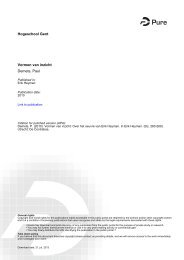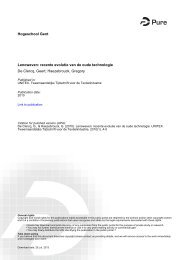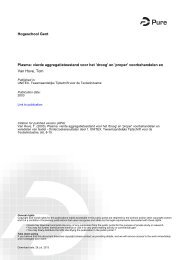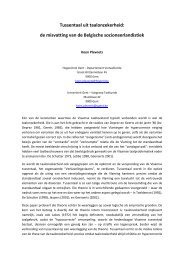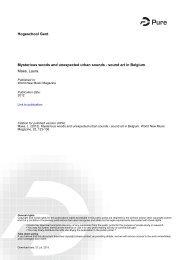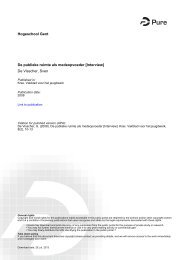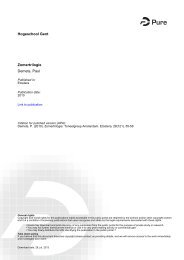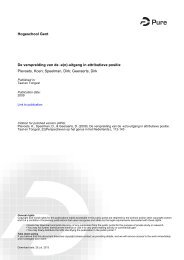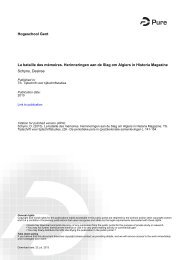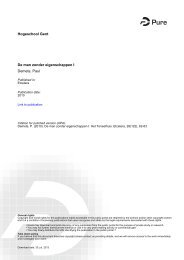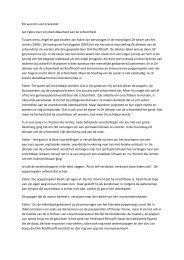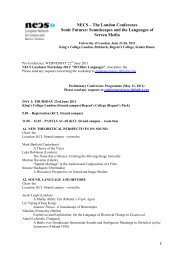- Page 1: Hogeschool Gent Biopreservation of
- Page 4 and 5: ir. Lieve Vermeiren Biopreservation
- Page 6 and 7: Woord vooraf Proefbuizen, labojasse
- Page 8: Table of contents
- Page 11 and 12: 3.4. EFFECT OF PROTECTIVE LAB ON TH
- Page 13 and 14: 1. INTRODUCTION....................
- Page 15 and 16: 2.8. STATISTICAL ANALYSES 189 3. RE
- Page 18 and 19: Introduction and objectives In rece
- Page 20 and 21: • Sub-objective 5 Chapter 5 aimed
- Page 22: Summary
- Page 25 and 26: Chapter 3 presented a systematic st
- Page 27 and 28: 10A and an atmosphere containing 50
- Page 30: Samenvatting
- Page 33 and 34: werden deze stammen beschouwd als m
- Page 35 and 36: ewaartemperatuur (4°C versus 7°C)
- Page 37 and 38: In-vitro testen toonden aan dat de
- Page 40 and 41: Chapter 1 Antagonistic micro-organi
- Page 42 and 43: esides lactic acid, including carbo
- Page 44 and 45: 1.4.3. The genus Pediococcus This g
- Page 46 and 47: taxonomy) and the present phylogene
- Page 48 and 49: 1.5.1. Fermentation end-products 1.
- Page 52 and 53: 1.5.2. Bacteriocins Bacteriocins, p
- Page 54 and 55: molecule inserts into the membrane
- Page 56 and 57: 1.5.3. Other antagonistic systems 1
- Page 58 and 59: explains why CMP, immediately after
- Page 60 and 61: Weissella Weissella viridiscens has
- Page 62 and 63: 2.3.3.3. Discolouration Green disco
- Page 64 and 65: eported an incidence of L. monocyto
- Page 66 and 67: The use of micro-organisms or their
- Page 68 and 69: 3.2.2. Organic acids In general, re
- Page 70 and 71: Furthermore, protective LAB can be
- Page 72 and 73: Fish, fish products and seafood Spo
- Page 74 and 75: Table 1.3. Effect of (non-)bacterio
- Page 76 and 77: performance as a biopreservative in
- Page 78 and 79: Table 1.6. Studies on the effect of
- Page 80 and 81: prevent them from growth of food bo
- Page 82 and 83: The application of the host-specifi
- Page 84 and 85: Multiplicity of infection (MOI) Pha
- Page 86 and 87: using Leuc. carnosum 4010 in frankf
- Page 88 and 89: activity of LAB in general, this se
- Page 90 and 91: effect (Gram et al., 2002). Several
- Page 92 and 93: for one or more of these vitamins o
- Page 94 and 95: clinical cases, patients were immun
- Page 96 and 97: different degrees and classify them
- Page 98: this way an equal distribution over
- Page 102 and 103:
Chapter 2 Evaluation of meat born l
- Page 104 and 105:
temperatures, the characterisation
- Page 106 and 107:
dextranicum LMG 6908 T , Leuc. carn
- Page 108 and 109:
2.6. Behaviour of 12 selected putat
- Page 110 and 111:
considered as unacceptable. Finally
- Page 112 and 113:
From the 74 remaining strains, only
- Page 114 and 115:
Among the isolates, 76% (28/37) was
- Page 116 and 117:
Within the group of isolated strain
- Page 118 and 119:
with fast growth rates at low tempe
- Page 120 and 121:
pH 6.3 6.2 6.1 6.0 5.9 5.8 5.7 0 5
- Page 122 and 123:
34th day of the storage period, alt
- Page 124 and 125:
Table 2.5. Summary of the LAB-count
- Page 126:
Chapter 3 In-vitro and in-situ grow
- Page 129 and 130:
1. Introduction A considerable part
- Page 131 and 132:
7°C and revived by transferring a
- Page 133 and 134:
The sensory quality of cooked ham s
- Page 135 and 136:
lesser extent compared to the LAB s
- Page 137 and 138:
LC2 and LM3 not significantly decre
- Page 139 and 140:
Sensory rejection was mainly based
- Page 141 and 142:
log10(cfu/g), respectively. It migh
- Page 144:
Chapter 4 Co-culture experiments de
- Page 147 and 148:
1. Introduction Interest in the rol
- Page 149 and 150:
growth characteristics, antibacteri
- Page 151 and 152:
1 g/l Peptone (Oxoid)) was prepared
- Page 153 and 154:
were sensitive to 8/11 tested antib
- Page 155 and 156:
Log10(cfu/g) Log10(cfu/g) 9 8 7 6 5
- Page 157 and 158:
On the other hand, no significant (
- Page 159 and 160:
Table 4.3. Evolution of the glucose
- Page 161 and 162:
Log10(cfu/g) Log10(cfu/g) 9 8 7 6 5
- Page 163 and 164:
day 28 in the HG-product. However,
- Page 165 and 166:
glucose. Buchanan & Bagi (1997) als
- Page 168:
Chapter 5 The interaction of the no
- Page 171 and 172:
1. Introduction Several authors hav
- Page 173 and 174:
(3) an interaction study at 7°C be
- Page 175 and 176:
3. Results and discussion The chemi
- Page 177 and 178:
Log10(cfu/g) 9 8 7 6 5 4 3 2 1 0 0
- Page 179 and 180:
Clearly, the growth of L. sakei 10A
- Page 181 and 182:
Table 5.2. Evolution of the pH of t
- Page 184:
Chapter 6 The sensory acceptability
- Page 187 and 188:
1. Introduction During the last dec
- Page 189 and 190:
mixture of Leuc. mesenteroides LM2
- Page 191 and 192:
to a sensory panel of 18 non-traine
- Page 193 and 194:
inoculation, 200 g portions of prod
- Page 195 and 196:
Buffering capacity (mmol lactic aci
- Page 197 and 198:
where LAB-growth results in sensory
- Page 199 and 200:
3.2.1. Antagonistic activity of L.
- Page 201 and 202:
In all five products, L. sakei 10A
- Page 203 and 204:
the glucose consumption in 10A-samp
- Page 205 and 206:
In general, CMP with such low pH-va
- Page 207 and 208:
3.3. Discussion 3.3.1. Antagonistic
- Page 209 and 210:
that cooked ring sausages were deem
- Page 212:
Chapter 7 The contribution of lacti
- Page 215 and 216:
1. Introduction The last two decade
- Page 217 and 218:
Table 7.1. Composition of the diffe
- Page 219 and 220:
In all three experiments, growth of
- Page 221 and 222:
2.5.2. Challenge experiment in CFS
- Page 223 and 224:
3. Results and discussion 3.1. Co-c
- Page 225 and 226:
However, cell numbers were analysed
- Page 227 and 228:
Log10(cfu/ml) or pH Log10(cfu/ml) o
- Page 229 and 230:
Log10(cfu/ml) Log10(cfu/ml) 10 9 8
- Page 231 and 232:
Log10(cfu/ml) Log10(cfu/ml) 9 8 7 6
- Page 233 and 234:
that case the pH of the CFS would h
- Page 235 and 236:
Log10(cfu/ml) Log10(cfu/ml) 9 8 7 6
- Page 237 and 238:
these experiments when there was st
- Page 240:
Chapter 8 Treatment with bacterioph
- Page 243 and 244:
1. Introduction Listeria monocytoge
- Page 245 and 246:
(7°C and 30°C). Experiments were
- Page 247 and 248:
L. monocytogenes cocktail, 100 µl
- Page 249 and 250:
3. Results and discussion 3.1. Effe
- Page 251 and 252:
susceptibility of the genus Listeri
- Page 253 and 254:
end-point for the microbial shelf-l
- Page 255 and 256:
therefore, be sufficient to control
- Page 257 and 258:
contaminated cooked meat products,
- Page 260 and 261:
General discussion, conclusions and
- Page 262 and 263:
possible that the bacteriocin was n
- Page 264 and 265:
manufactured cooked meat products (
- Page 266 and 267:
deviations can be prevented and led
- Page 268:
List of abbreviations
- Page 271 and 272:
pfu plaque forming unit PPS Pepton
- Page 274 and 275:
References 1. Aasen, I.M., Markusse
- Page 276 and 277:
26. Berry, E.D., Liewen, M.B., Mand
- Page 278 and 279:
50. Buncic, S., Avery, S.M. & Moorh
- Page 280 and 281:
75. Devlieghere, F., Debevere, J. &
- Page 282 and 283:
99. Foegeding, P.M., Thomas, A.B.,
- Page 284 and 285:
125. Hudson, J.A., Billington, C.,
- Page 286 and 287:
150. Korkeala, H., Alanko, T., Mäk
- Page 288 and 289:
174. Marceau, A., Zagorec, M. & Cha
- Page 290 and 291:
nonbacteriocinogenic Carnobacterium
- Page 292 and 293:
style green olive fermentations. Ap
- Page 294 and 295:
253. Stratford, M. (2000). Traditio
- Page 296:
277. Vitas, A.I. & Garcia-Jalon, V.
- Page 300 and 301:
Curriculum vitae Curriculum vitae L
- Page 302 and 303:
of Listeria monocytogenes by the no
- Page 304 and 305:
2. ILSI Europe 2nd International Sy
- Page 306:
13. EFSA Colloquium On Microorganis



